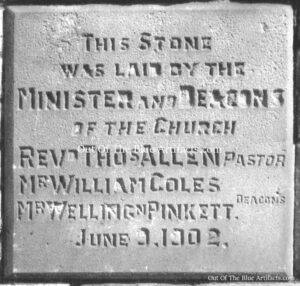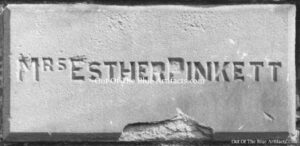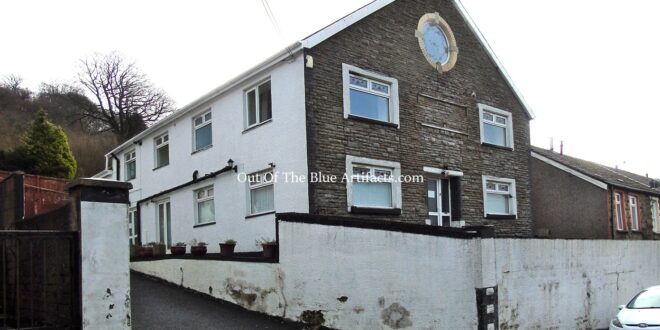English Baptist Chapel Zion – Cwmtillery.
There isn’t a great deal of information on this chapel, although the Baptist cause began at Cwmtillery in the late 19th century. Mr Arthur Tilney put forth plans to the council for the building of a chapel at East Side, Cwmtillery.
The First Chapel.
In 1899, the first chapel in connection with the English Baptist Chapel at East Side, Cwmtillery was a small wooden shed covered in zinc sheets. I’m not sure if this shed was actually built, as this building was not looked upon favourably with council planning.
Planning Refusal.
On Friday 14th of April 1899, the council rejected the plans for the building of a Baptist church at Cwmtillery, giving the reason that it was no more than a tin shed 20′ feet by 12′ feet and the council wouldn’t want these kinds of things littering the landscape. Upon hearing this, the Cwmtillery Baptists applied for permission to use the school as a temporary chapel (though reports doesn’t state which school was used).
The Baptism Services.
On Monday 5th of June 1899, it was reported that the movement was to meet at the Colliers Hall Cwmtillery for the purpose of organising a committee. The following Sunday a Baptismal Service was held in the woods above Blaentillery. Rev T. T. Evans and Rev T. Griffiths conducted the service. There were 350 people present to hear the address and Rev T. T. Evans baptised six people. It was reported that the baptisms took place in what was described as a mud-hole on the side of the mountain.
The Chapel Building.
In 1902 a plan for a properly constructed stone chapel was put to the council and the project went ahead.
The Contractor and Architect.
The contract for the construction of the chapel (as seen on the 1962 map in the featured image) was given to Mr David Powell, contractor of 81 Newall Street, Abertillery at a cost of £570. The architect was Mr George C. Hillard of Market Chambers, Abertillery. The site was leased for 99 years at 1d. per yard and the contract let for £570. Accommodation was to be for 250 to 300 people.
 The Ceremony of the laying of the Foundation Stones.
The Ceremony of the laying of the Foundation Stones.
On Monday 9th of June 1902, the ceremony of the laying of the Foundation Memorial Stones took place. The Rev Thos Allen presided. The first stones were laid by Rev T. Allen, Mr Coles and Mr Wellington Pinkett (as seen left) on behalf of the church and deacons. Secondly by Mr John Matthews on behalf of the choir and Mr Joseph Aaron on behalf of the Sunday School.
Others who participated in the laying of the stones were as follows – Mrs Phoebe Cooper; Misses M. M. and H. Lewis of Newport; Miss Alice Holbrook of Brynteg; Mrs Lewis of Aberbeeg; Mr & Mrs Percy Matthews; Mr & Mrs E. Barnes; Messrs T. H. Prichard; Mr John Aaron; Mr D. Powell and Miss Williams, daughter of Mr E. J. Williams: Arrangements were made for a stone to be laid on behalf of the Blaenau Gwent Baptist Church and Sunday School.
The subscriptions received during the day were as follows – Pastor & deacons £7.; Choir and Sunday school £14.; Blaenau Gwent Baptist Church and Sunday school £10.; Mrs P. Cooper £5. 5s.; Misses M. M. and H. Lewis of Newport £5.; Mrs Lewis of Aberbeeg £5.; Miss Holbrook of Brynteg £2. 10s.; Mr H. A. Price £5. 5s.; Mr & Mrs Edwin Barnes £5.; Mr T. H. Prichard £5.; Mr John Aaron £1. 10s.; Mrs Percy Matthews £1.; Mr E. J. Williams £5. 5s.; Mr David Powell contractor for the chapel £5.;  Mrs Esther Pinkett (as seen right) £1. 7s.; Mr William Escott £1.; After the collections, short addresses were delivered by Messrs Thos Bevan and William Taylor of Abertillery and Mr Williams of Blaenau Gwent Sunday School. A Bible was presented to the stone layers as a memento.
Mrs Esther Pinkett (as seen right) £1. 7s.; Mr William Escott £1.; After the collections, short addresses were delivered by Messrs Thos Bevan and William Taylor of Abertillery and Mr Williams of Blaenau Gwent Sunday School. A Bible was presented to the stone layers as a memento.
The Zion.
The chapel was also known as the Zion Baptist Chapel, as seen on maps and various newspaper reports.
Photographs of both memorial stones were supplied courtesy of Mr Phillip Pinkett.
The Later Years.
The church became derelict in the 1980’s and later purchased, renovated and turned into a Bed & Breakfast accommodation called Mynydd Lodge.
Point of interest – Wellington and Esther Pinkett were my great-grandparents, Mr Wellington Pinkett was a deacon of the chapel and was a native of Yate, Gloucestershire. On the 1871 census there were two families of Pinkett’s (misspelled) Pincott, that migrated to Cwmtillery. Mr William Pinkett aged 45 and his wife Maria with their children George, Margaret, John and Elizabeth. They were accompanied by his eldest son and family Mr William Pinkett aged 23 with his wife Mary and his brothers, one of whom was Wellington aged 18 (who later became deacon of the chapel) along with a cousin Mr John Pugh. They all came to work at Cwmtillery Colliery and lived at the South Wales Colliery Company houses at Cwmtillery.
Wellington and Sarah Ann Pinkett.
Mr Wellington Pinkett’s first wife was Miss Sarah Ann Evans, of Blaina, born 1853, they had one child together, Miss Elizabeth Pinkett born in 1874 at Cwmtillery and were living at Roberts Row, Cwmtillery. Elizabeth Pinkett married Henry Pocock, of Cwmtillery. Wellington Pinkett’s first wife Mrs Sarah Ann Pinkett sadly passed away in 1886 at 33 years of age.
Wellington and Esther Pinkett.
Mr Wellington Pinkett’s second wife was Miss Esther Perrott, born in 1866. Miss Esther Perrott was originally from Bristol, she came to Abertillery with her family in the 1870’s and was employed by Mr Joseph Wallace (South Wales Colliery Manager) as a maid, at his home at Fern Villa, Penybont. Wellington and Esther Pinkett lived at Bridge Cottage, Cwmtillery and later Brynmorgan Terrace. They had a daughter Florence Pinkett, born in 1888, a son William John Pinkett (my grandfather) born in 1891, a son George Pinkett, born in 1896 and a daughter Annie Maud Pinkett, born in 1899.
The Death of Mr Wellington Pinkett.
In 1909 Mr Wellington Pinkett passed away, Esther re-married. Her second husband was Mr Herbert Fenner, they stayed at 18 Brynmorgan Terrace, Cwmtillery.
William John and Mary Edith Pinkett.
Mr William John Pinkett (my grandfather) the son of Wellington was married to Miss Mary Edith Pinkett, born in 1893 at Brynmawr, Brecknock. Mary Edith was the daughter of Mr David and Mary Ann Wilkins, David Wilkins was a clerk for Messrs John Lancaster, Colliery Company at Blaina. William John and Mary Edith lived at Cromwell Street, Princess Street and most of their life at No.19 Glandwr Street, Abertillery. Mr William John Pinkett played rugby for Abertillery, Blaenau Gwent and Crumlin R.F.C. in the 1930’s, worked in the Arrael Griffin Colliery and later the Remploy, Bridge Street, Abertillery. William John and Mary Edith Pinkett’s family were – William Jnr, George, Marge, Winifred, Jeanette (my mother) and Jack.
 Out Of The Blue Artifacts A Library of a lifetime of collecting
Out Of The Blue Artifacts A Library of a lifetime of collecting
